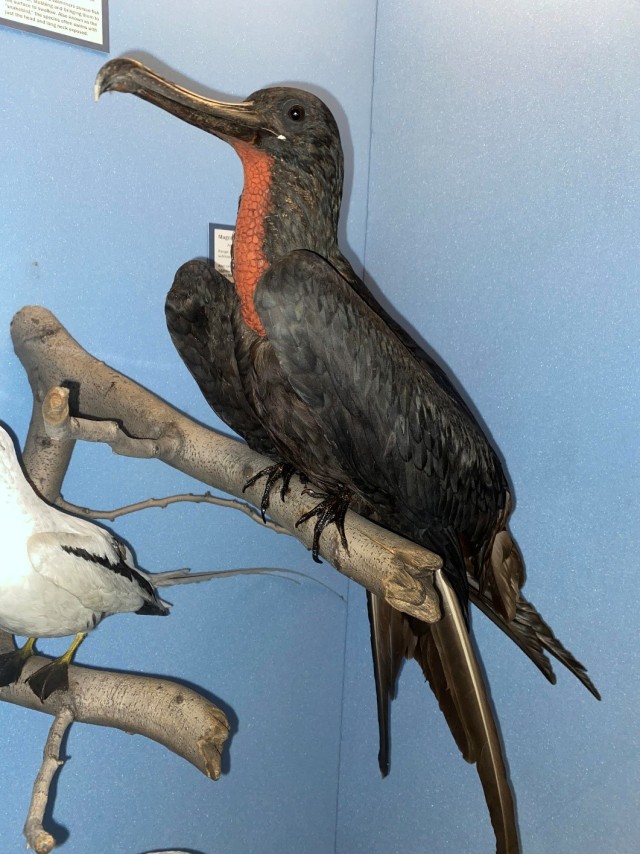by Nicholas Sauer
Fish and other aquatic animals aren’t the only ones who go splish-splash is an ocean biome. Let’s not forget our feathered friends, the birds. Today, we’ll be taking a closer look at one of the most conspicuous of all seabirds, the Magnificent Frigatebird (fregata magnificens), also known as the Man o’ War Bird.

These birds primarily live and breed on the islands of the Caribbean having been observed by scientists and bird watchers on the Marquesas Keys and Dry Tortugas. They are also found nesting on human-made structures like pier pilings from Texas’s Galveston Bay to the Atlantic coast of southern Florida. Frigatebirds make both the Atlantic and Pacific Oceans their home, flying on occasion over the isthmus of Panama. In fact, Magnificent Frigatebirds are able to remain airborne for up to a month and a half over their watery environs without the need to land. Some frigatebirds even adapt their hunting and flying practices to specific wind patterns that will allow them to travel and forage more efficiently.
The species is well-suited for such a lifestyle with a wingspan averaging 7.5 feet and a lengthy forked tail which maximizes their aerodynamic abilities. If you ever catch sight of a Magnificent Frigatebird from the shoreline you will see that this species is a stark example of sexual dimorphism. The female is covered in dark brown or black feathers and has a white breast and underbelly. The males are entirely black with a bright red throat pouch which they inflate like a balloon for mating purposes. To attract a mate, the males, often perched together among mangrove trees, will inflate their throat pouches, and then raise and vibrate their wings, calling out with guttural shrieks. When a female chooses a mate, the male takes on the responsibility of finding sticks to build a platform-like nest. He brings these materials to the female who then typically builds the nest on her own. Figatebirds live in colonies, but these communities are by no means free of strife. Both parents incubate a single egg between them each mating season and feed their young after it has hatched. It is paramount that the mother and father maintain vigilance over their nest. At least one parent must be present, or otherwise fellow members of the colony will prey on their neighbors’ eggs and newborns. After twenty to twenty-four weeks the juvenile is able to fly for itself. However, another sixteen weeks will elapse before the young frigatebird reaches full maturity and the mother feeds it for the last time.
Magnificent frigatebirds feed on flying fish, tuna, squid, jellyfish, and crustaceans. As opportunistic feeders they aren’t picky about their dietary choices. Interestingly enough, when hunting they never swim or float on the surface of the water. When swooping down to catch aquatic prey, they confine themselves to surface-dwellers, specifically life that resides in the top inch of water, that is, the epipelagic or “sunlight” zone.
Sometimes frigatebirds will dispense with hunting and foraging altogether and let other birds do the work. They are what scientists describe as “kleptoparasitic.” In other words, they are pirates stealing food literally from the mouths of other birds. Frigatebirds use their intimidating size, ferocious bill, and acrobatic flight abilities to wrest fish from the mouths of almost any bird they can, from seagulls to blue-footed boobies and even brown pelicans. Either that, or they force the weaker birds to regurgitate their prey during midair skirmishes. In these battles, the frigatebird often bites and tears at the target bird’s tail feathers until the victim submits to highway robbery. The frigatebird then catches their target’s lunch before it drops back into the sea. This strategy helps the frigatebird conserve energy and minimize risk while hunting and also gives the bird its extravagant name. Like the pirate ships and British navy man o’ wars of history and myth, the Magnificent Frigatebird prowls the tropics and takes what it likes by a show of force. These beautiful but fierce seabirds demonstrate the intricate adaptions—flying on specific winds and the use of kleptoparasitism—necessary for a creature to thrive in an environment divided between land and sea.
Nicholas Sauer is a Gallery Experience Presenter in CMNH’s Life Long Learning Department. Museum staff, volunteers, and interns are encouraged to blog about their unique experiences and knowledge gained from working at the museum.
References
De Monte, Silvia et al. “Frigatebird behaviour at the ocean-atmosphere interface: integrating animal behaviour with multi-satellite data.” Journal of the Royal Society, Interface 9, no.77 (2012): 3351-8.
Kaufman, Ken. “Magnificent Frigatebird.” National Audubon Society. Accessed 29 July 2021. <https://www.audubon.org/field-guide/bird/magnificent-frigatebird>.
“Layers of the Ocean.” National Weather Service: National Oceanic and Atmospheric Administration. Accessed 29 July 2021. <https://www.weather.gov/jetstream/layers_ocean>.
Osorno, J.L., et al. “Kleptoparasitic Behavior of the Magnificent Frigatebird: Sex Bias and Success.” The Condor 94 (1992): 692-698. <https://sora.unm.edu/sites/default/files/journals/condor/v094n03/p0692-p0698.pdf>.
Stittleburg, Vicki and Maria Hart. “Magnificent Frigatebird.” Houston Audubon Society. 2021. <https://houstonaudubon.org/birding/gallery/magnificent-frigatebird.html>.
Related Content
Survival of the Fishiest: Astonishing Adaptations of the Aquatic World
Super Science Saturday: Splish Splash (August 14, 2021)
Carnegie Museum of Natural History Blog Citation Information
Blog author: Sauer, NicholasPublication date: August 13, 2021
